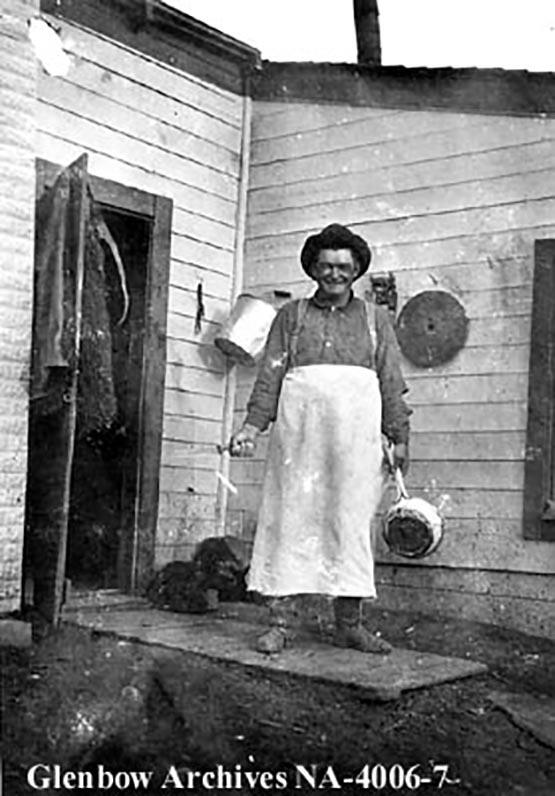July 5, 2023
Explore the origin and history of the Calgary Stampede Pancake Wagon

For 10 days every July, the smell of maple syrup and sizzling pancake breakfasts dominates the city of Calgary. These breakfasts have become synonymous with western hospitality and the spirit of the Stampede, but where did this tradition come from?
As we celebrate 100 years of pancake breakfasts this July, let’s dig in and take a look back to where this practice originated, and the man who started it all.
Back to the beginning
Calgary’s first exhibition was held in 1886 and was presented by the Calgary and District Agricultural Society. This fair celebrated the farmers and ranchers of the district and gave them the opportunity to showcase their animals and industries. It was also used to entice more people to move to the newly developing town of Calgary, which had only just been incorporated in 1884.
The Calgary Agricultural Society would go on to create an exhibition space on the banks of the Elbow River, in an area now known as Victoria Park.
By 1912, Calgary had become a bustling city. People were moving away from an agrarian lifestyle and becoming more metropolitan. It was at this time that an American trick roper named Guy Weadick came to town with the hopes of creating a great spectacular — a celebration and tribute to the ranching past of what was already being called the “Old West.” With the financial backing of local businessmen and ranchers Patrick Burns, A.E. Cross, A.J. McLean and George Lane, who would become known as the “Big Four,” Weadick created the first Calgary Stampede.
Creating the Greatest Outdoor Show on Earth
The Calgary Exhibition and the Stampede joined together in 1923, under the direction of Weadick. It was the first time these events were combined. Determined to create an even-more-unforgettable spectacular, Weadick turned to his friend, Jack Morton, commonly known as “Wildhorse Jack.”
Morton, a rancher from Rosebud, Alta., was famed for his ability to tame wild horses and for being accompanied almost everywhere by his two pet badgers (who were much less tame than the horses!). A passionate supporter of rodeo, he was one of the founders of the Gleichen Stampede, and was known for his pranks, mischievous spirit and unfailing generosity. When people in need came to Morton, he never turned them away.
Morton and Weadick discussed a new event for the inaugural Exhibition and Stampede that would add to the celebration that Weadick envisioned, while still celebrating ranching culture. Morton thought about long cattle drives and about their most important member — the cook.
Feeding the masses

Horace Inkster, cook at Jack Morton's C-X ranch, Rosebud Creek, Alta.
Glenbow Library and Archives Collection, Libraries and Cultural Resources Digital Collections, University of Calgary
The cook, or “cookie,” was responsible for ensuring the crew was well fed during the cattle drive. While some form of mobile kitchen had always existed, it was the 1866 invention of the chuckwagon that really improved life on the trails. Cooks were now able to provide hot meals to the crew with much greater ease, tremendously improving the experience of those on the cattle drive.
The value of the cook was never overlooked. In some cases, the cook would be paid as much as four times the amount as other crew members. The cook would wake up early to prepare hot coffee and breakfast for the crew, which often consisted of bacon, biscuits and pancakes. After breakfast was cleaned up, the cook would reload the chuckwagon and race off to the day’s destination to begin preparing a hot supper, waiting for the team to catch up hours later.
And so, thinking of the chuckwagon cooks racing to set up camp before the cattle drive crew, Morton created a new event for Weadick’s expanded Stampede: the chuckwagon race.
And what better way to promote his new event, and the Stampede itself, than with a traditional cowboy breakfast, straight from a chuckwagon?
The first pancake breakfast

Horace Inkster, serving pancakes at Calgary Exhibition and Stampede street breakfast, Calgary, Alberta.
Glenbow Library and Archives Collection, Libraries and Cultural Resources Digital Collections, University of Calgary
On July 13, 1923, Morton and his team from the CX Ranch rode their chuckwagon — dubbed the Pancake Wagon — down 8th Avenue. They found a nice spot and created a makeshift corral for their horses, lining it with hay. Then they set up their cookstove and started turning out pancakes for anyone who wanted one. They provided their guests with butter, maple syrup and endless stories of their adventures. Other chuckwagon teams soon joined in, spreading frontier hospitality to all who came by.
The next year, Morton and his team were back and the event continued to grow. Chuckwagon teams from all over were now coming to support the pancake breakfasts. By the end of the 1920s, the pancake breakfast had become a fully integrated Stampede tradition, and we have never looked back.
Eventually, other groups, among them businesses, politicians, and diverse religious and social organizations, began to host their own breakfasts. They can now be found in every corner of the city. They are a way to give back to the community and partake in the generous spirit of western hospitality.
“The Stampede Breakfast began as a gesture of hospitality, and, although it continues to serve as a symbol of Calgary’s generosity, it is now equally important in its role of advocating for and supporting charities and non-profits,” says Aritha van Herk, a professor in the University of Calgary’s Department of English and author of Stampede and the Westness of West.
This Stampede, as you pour maple syrup on your pancakes, don’t forget to tip your hat to Jack Morton in thanks.
To find out more about Jack Morton and the history of the Calgary Stampede, visit the Taylor Family Digital Library or the Archives and Special Collections website.










